
 | ||||||
 | ||||
The company has ceased trading. The commercial parts of this site have closed.
Philip has taken over the site and intends to redevelop it as a not-for-profit internet resource.
We have put our knowledge of quiet computers into practice in our state-of-the-art quiet machines.
 Sources of computer noise
Sources of computer noise
The noise emissions from PCs are primarily an unwanted side-effect of movement in mechanical devices. Current PCs contains two classes of mechanical device that are responsible for most of the acoustic noise emitted. These are storage devices and fans.
Storage devices: PCs usually use hard drives as the main mass storage medium. The noise from hard drives comes from the vibrations of their spinning discs and moving heads. Floppy drives, CD and DVD drives and similar devices also contribute noise, although not usually so continuously.
Fans: The power consumed by the components of the computer ends up converted into heat (another unwanted side-effect). If the parts of a PC were allowed to overheat they may stop working or suffer damage; their working life may be shortened. Air cooling by fans (forced convection) is the cost-effective solution, but noise is generated by vibrations in the fan bearings by the airflow itself.
One way to solve the PC noise problem in an audio recording or monitoring environment is to locate the computer in a different room. However, this can be inconvenient or even impossible. Some consideration can be given to siting the PC, even if it has to be in the same room. For example, keep the machine away from recording microphones, and do not place it on resonant furniture (which may intensify any noise transmitted to it).
At the same time, we should do what we can to make the PC hardware itself quieter. There are two prongs of strategy for achieving this, reducing the noise at source and soundproofing.
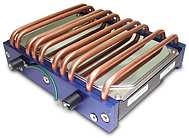 Using rubber or similar materials to mount the moving mechanical PC components can dampen the transmission of vibrations and reduce noise emissions. For example a disk
drive bay can be supported on anti-vibration mounts. Foam-lined sleeve enclosures are sometimes used to tame the noise of hard drives; however, they are incompatible with high-performance modern drives, which get too hot. The innovative Zalman Heatpipe Coolers, on the other hand, do a good job; they acoustically isolate the drive, keep the drive cool, and are robust enough to fit to systems being shipped. The Silentmaxx Aluminium Silencer is also an effective product, but it is more costly and can be difficult to fit (because of non-standard screw hole positions).
Using rubber or similar materials to mount the moving mechanical PC components can dampen the transmission of vibrations and reduce noise emissions. For example a disk
drive bay can be supported on anti-vibration mounts. Foam-lined sleeve enclosures are sometimes used to tame the noise of hard drives; however, they are incompatible with high-performance modern drives, which get too hot. The innovative Zalman Heatpipe Coolers, on the other hand, do a good job; they acoustically isolate the drive, keep the drive cool, and are robust enough to fit to systems being shipped. The Silentmaxx Aluminium Silencer is also an effective product, but it is more costly and can be difficult to fit (because of non-standard screw hole positions).
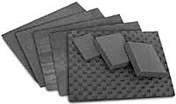 The aim of sound insulation is to keep the noise in. The complication is that we also need to let heat get out. Acoustic matting material can
be applied to the PC case to make it quieter. This can both attenuate airborne noise and dampen vibrations transferred through the PC structure. It is desirable that the materials selected do not get smelly when they warm up. We can fit AcoustiPack computer case sound dampening. AcoustiPack consists of a layer of studio-grade acoustic foam, a high-attenuation very dense underlying layer and an adhesive backing.
The aim of sound insulation is to keep the noise in. The complication is that we also need to let heat get out. Acoustic matting material can
be applied to the PC case to make it quieter. This can both attenuate airborne noise and dampen vibrations transferred through the PC structure. It is desirable that the materials selected do not get smelly when they warm up. We can fit AcoustiPack computer case sound dampening. AcoustiPack consists of a layer of studio-grade acoustic foam, a high-attenuation very dense underlying layer and an adhesive backing.
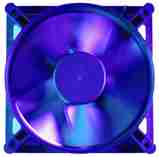 Optimised cooling
Optimised cooling
Fans used in combination with heatsinks represent the cost-effective cooling solution for PCs. In the typical PC, little or no attention is paid to sound levels. In ordinary machines, the airflow through the computer is not seriously considered, and all the fans are left running at full speed whether this is necessary or not. It is different with our quiet PC systems, which benefit from airflow design, balanced inflow/outflow, and our proprietary central airflow control electronics.
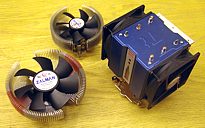 The processor heatsink is an important component. We favour the
Themaltake Silent Tower or the Zalman flower heatsinks, which seek to provide a large cooling surface. These devices are fitted with large, slow moving fans.
The processor heatsink is an important component. We favour the
Themaltake Silent Tower or the Zalman flower heatsinks, which seek to provide a large cooling surface. These devices are fitted with large, slow moving fans.
With respect to the fans themselves, their motors, blades and bearings can be designed to run quietly. Many designated low-noise fans are available, but often they are not actually very special. Also, manufacturers' specifications are often not directly comparable. It is actually easier and more accurate to test sample fans ourselves. So that we can make the quiet PC, this is what we have done in our workshop. We favour Zalman quiet fans, which have a good speed range, and are a good match for the drivers of our central airflow control system. Efficient and properly cooled power supplies are an important part of the quiet PC or silent PC.
From the noise point of view, for the same air movement capacity. it is better to run more and/or larger fans at low speed than fewer or smaller fans at full speed. So the story is bigger fans and more fans, but none of them ought to run faster than is needed to maintain proper component temperatures.
Our central airflow control system allows independent adjustment of individual fan speeds, so that the full fan set always works together in a balanced way.
 Airflow pattern design
Airflow pattern design
The fluid dynamics of the case airflow pattern must be designed to guide cool ambient air to a hot running system component, and to remove hot air from this component to the outside. There is no point in having the fans just stirring up hot air. Inflow fans are usually a necessity in good airflow design, and machines with dummy inlet grilles are not really up to the job. We can fit gaskets to the inlet fans to acoustically isolate them from the case, and to improve their effectiveness.
Fan sizes and speeds (therefore, velocity pressures) should also be selected to achieve a proper airflow pattern around the PC hardware. This is possible with our central airflow control system. For example, in a rackmounted unit, the inflow fans (at the front) should work harder than the outflow fans (at the back). This will create a positive (that is, above ambient) static pressure inside the case. This ensures that hot air from within the rack cabinet is not drawn into the PC case.
To improve efficiency and reduce noise generated by the simple movement of air, we minimise obstructions in the airflow path. We make sure that fan grilles have adequate apertures, and we carefully consider the location of components and the routing of cables. We can fit acoustic foam and custom metalwork, to create ducts which guide the air around the case.
We pay attention to the selection of efficient power supplies and low impedance material for inflow filters. We recommend SilenX power supplies, which are probably the quietest available.
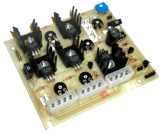 Our central airflow control electronics uses thermistors to continuously measure temperatures in the system, and regulate cooling according to need. So that the fans only run as
fast as needed at a given moment and not more. Also the fan speeds are coordinated to maintain a balanced and efficient stream of air.
Our central airflow control electronics uses thermistors to continuously measure temperatures in the system, and regulate cooling according to need. So that the fans only run as
fast as needed at a given moment and not more. Also the fan speeds are coordinated to maintain a balanced and efficient stream of air.
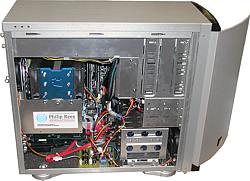 This central airflow control system is designed and manufactured by ourselves, and is exclusively fitted to computers built by us. Its operation is completely independent of
the computer motherboard, so it imposes no overhead on the computer hardware or software and is compatible with any platform.
This central airflow control system is designed and manufactured by ourselves, and is exclusively fitted to computers built by us. Its operation is completely independent of
the computer motherboard, so it imposes no overhead on the computer hardware or software and is compatible with any platform.
Our state-of-the-art tower case systems are widely praised for being astonishingly quiet. They feature quality parts and numerous custom design details, building on our years of experience in creating very quiet computers.
By choosing components known to be quiet and cool running, one can build an extra quiet computer.
 Formerly, everybody (including us) chose the reliable
Seagate Barracuda family of hard drives as quiet PC drives. However, due to some sort of patent litigation, these models no longer have quiet seek (SoftSeek) technology, so they make little chinking noises when active. At the time of writing, we believe that Samsung SpinPoint models are now the quiet drives of choice – they certainly are very quiet, and do not usually call for any further noise reduction measures. When it is necessary to suppress the residual noise, we recommend Zalman Heatpipe Coolers.
Formerly, everybody (including us) chose the reliable
Seagate Barracuda family of hard drives as quiet PC drives. However, due to some sort of patent litigation, these models no longer have quiet seek (SoftSeek) technology, so they make little chinking noises when active. At the time of writing, we believe that Samsung SpinPoint models are now the quiet drives of choice – they certainly are very quiet, and do not usually call for any further noise reduction measures. When it is necessary to suppress the residual noise, we recommend Zalman Heatpipe Coolers.
 The processor (CPU) is the single most significant source of heat in a modern pc. The Intel Pentium 4 includes a feature called thermal monitor which, when activated by an
excessive on-chip temperature, lowers the CPU temperature by momentarily throttling the
internal CPU clock speed. We don't want this to happen during normal use, so we must ensure that the processor is adequately cooled. This is an extra reason for choosing to use
our central airflow control system and a high performance cooler to make your music computer into an almost silent PC.
The processor (CPU) is the single most significant source of heat in a modern pc. The Intel Pentium 4 includes a feature called thermal monitor which, when activated by an
excessive on-chip temperature, lowers the CPU temperature by momentarily throttling the
internal CPU clock speed. We don't want this to happen during normal use, so we must ensure that the processor is adequately cooled. This is an extra reason for choosing to use
our central airflow control system and a high performance cooler to make your music computer into an almost silent PC.
![]() In-depth description of our state-of-the-art quiet machines
In-depth description of our state-of-the-art quiet machines
![]() other articles - technical writings by Philip Rees
other articles - technical writings by Philip Rees
![]() Audio interfaces product directory
Audio interfaces product directory
![]() to Phil Rees Music Tech computer systems
to Phil Rees Music Tech computer systems
![]() to Phil Rees Music Tech home page
to Phil Rees Music Tech home page